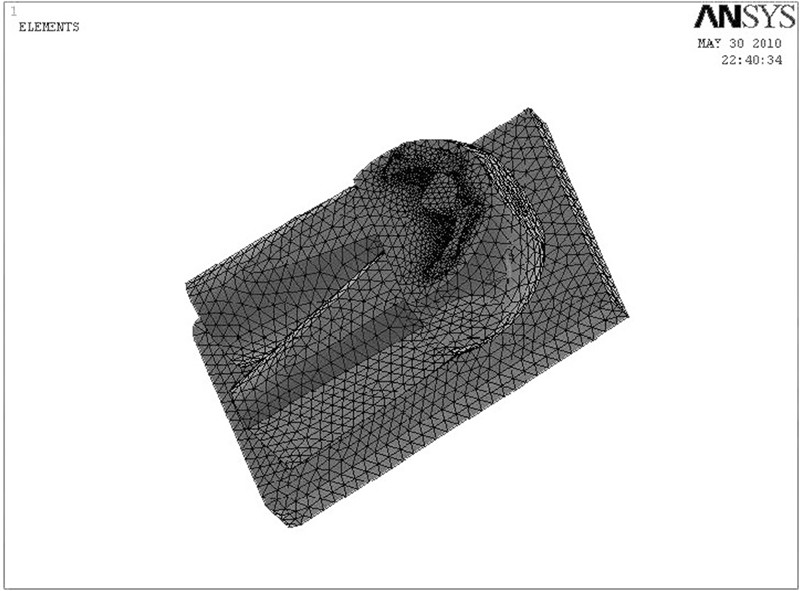 |
| 图 1 人-座椅坐垫有限元模型Fig. 1 Human-seat cushion finite element model |
| 图选项 |
2 坐姿下应力分布有限元计算 2.1 施加载荷通过在脊柱以及大腿上表面施加不同的压力来模拟躯干重力以及垂直方向的过载.鉴于战斗机最大过载不超过9g,且大部分时间处于低过载状态,本文对如表 1的6种过载进行了仿真计算.表 1 所施加载荷及部位 Table 1 Loads and locations
| 过载加速度/g | 施加压力/kPa | |||
| 脊柱处 | 髋骨处 | 腰部 | 大腿 | |
| 1 | 84 | 6.5 | 1 | 4 |
| 2 | 168 | 13.0 | 2 | 8 |
| 3 | 252 | 19.5 | 3 | 12 |
| 4 | 336 | 26.0 | 4 | 16 |
| 5 | 420 | 32.5 | 5 | 20 |
| 8 | 672 | 52.0 | 8 | 32 |
表选项
2.2 仿真计算首先进行1g环境下的有限元仿真,将计算得到的坐应力分布与实验获得的应力分布进行比较用于验证模型的有效性,然后再分别进行表 1中其他5种过载加速度下的仿真计算. 3 模型验证为了验证模型的有效性,将人-坐垫接触面的仿真数据与实验中测得的应力分布进行比较.如果仿真与实验的应力分布以及应力值大小相对应,则认为建立的仿真模型有效. 3.1 坐应力实验本文采用Pliance-X压力坐垫对坐姿下人-坐垫接触面坐应力进行测量.Pliance-X压力传感器排列方式为16×16共计256个传感器,可以较为准确地测量人-坐垫坐应力分布.实验中,受试者上身直立端坐在坐垫上,待压力测量数据稳定后进行记录,记录20s.仿真计算中坐垫的物理参数与实验中实际坐垫相同.施加在臀部模型上的应力也是根据受试者实际体重换算而来. 3.2 应力分布对比图 2为仿真计算和实验应力云图,可以发现两者坐应力分布情况基本相同,即在坐骨结节部位出现应力集中现象,并以此为中心向四周逐渐降低.
 |
| 图 2 坐应力分布的仿真与实验结果对比Fig. 2 Simulation and experiment results of sitting pressure |
| 图选项 |
3.3 坐骨结节连线上应力分布图 3显示了两个坐骨结节连线上的应力分布.仿真计算中坐骨结节处最大应力为44kPa,实验中坐骨结节处最大应力为50kPa,两者基本相同.仿真计算中平均坐应力为16.24kPa,实验中坐应力为15.12kPa,两者也基本相同.在坐应力的变化趋势方面,仿真计算和实验结果,都是在坐骨结节处坐应力最大,并以坐骨结节为中心往两边逐渐减小.由此可见,仿真计算和实验得到的应力分布具有很大的一致性.
 |
| 图 3 仿真和实验坐骨结节连线上应力分布对比Fig. 3 Sitting pressure across the ischium nodule line from simulation and experiment |
| 图选项 |
通过比较仿真和实验数据的坐应力分布云图以及坐骨结节连线上的应力变化曲线,仿真和实验结果在最大坐应力、平均坐应力和变化趋势上具有较好的相似性,仿真模型可以真实地反映实际的坐应力分布情况,说明所建立的有限元模型有效可行. 4 计算结果与分析 4.1 总体应力分布图 4为仿真模型中的Von Mises等效应力分布情况.Von Mises等效应力是基于剪切应变能的一种等效应力,服从第四强度理论,即其认为形状改变比能是引起材料屈服破坏的主要因素,适用于本文模型中的塑性变形情况.从图 4应力分布外表面来看,其应力主要集中在骨盆部位,这与坐姿时应力分布的实际情况相符.
 |
| 图 4 模型上的等效应力分布Fig. 4 Von Mises pressure distribution on the model |
| 图选项 |
4.2 坐垫上应力分布图 5为人体模型与坐垫接触面上的Von Mises等效应力分布.由图可知,在臀部左右坐骨结节处应力值最大,并以此向周围逐渐减小,满足舒适坐垫的体压分布曲线[11].
 |
| 图 5 坐垫上的等效应力分布Fig. 5 Von Mises pressure distribution on the cushion |
| 图选项 |
相关的研究发现平均坐应力、最大坐应力、接触面积大小以及对称性等指标可以用来表征坐应力分布与坐垫舒适性的关系.通过图 5坐垫上应力分布云图以及数据,可以计算不同坐垫下的平均坐应力、最大坐应力等相关指标,以此来判断不同坐垫的舒适性. 4.3 骨盆上应力分布图 6为骨盆应力分布外观图和内部切片图.可看出,在骨盆的坐骨结节以及骶髂关节部位应力分布最为集中,而研究表明,46%的飞行员患有腰椎间盘突出[19],这与骶髂关节部位的应力过大有关,因此可将该部位的应力大小作为舒适性评价的依据.参照骨盆相应部位损伤时所承受的最大应力,可通过这几个部位的应力大小来判断人承受过载加速度的极限,以及选取合适的坐垫材料,设计合理的坐面倾角等.这对于减轻和预防飞行员执行过载任务时的身体损伤具有重要的参考价值.
 |
| 图 6 坐姿下骨盆应力分布Fig. 6 Pressure distribution of the pelvis |
| 图选项 |
4.4 不同过载下应力分布 4.4.1 不同过载下人体内部最大应力模型中最大应力为Z方向应力的最大值.图 7为不同过载加速度下的最大应力.由图可知,在不同过载加速度下,即给模型施加相应倍数的压应力,模型中的最大压应力与施加的压应力是线性关系.
 |
| 图 7 不同过载加速度下模型最大应力Fig. 7 Maximum pressure on the interior human body at different overload accelerations |
| 图选项 |
4.4.2 不同过载下坐垫上最大应力不同过载加速度下坐垫上的应力分布趋势是大体一致的,但其最大应力具有一定的差异.图 8为不同过载加速度下坐垫上的Z方向最大应力值.由图可知,不同过载加速度下,坐垫上的最大应力与施加的压应力之间是线性关系.
 |
| 图 8 不同过载加速度下坐垫最大应力Fig. 8 Maximum pressure on the cushion at different overload accelerations |
| 图选项 |
通过图 7和图 8可知,本文模型中应力与过载加速度之间为线性关系,这种关系有助于减少计算量,即如果计算得到一种过载加速度下的应力分布情况,便可推出其他过载加速度下的应力分布.但需要注意的是,由于本文中模型采用的是各向同性材料,与真实人体的生物力学特性存在一定差异,因此本文结果不一定真实反映不同过载下人体内部应力的变化情况. 5 结 论1) 本文建立了人-座椅坐垫模型,其中人模型包括骨盆等骨组织以及臀部和大腿等软组织,并模拟计算了地面环境下坐姿时的应力分布情况,通过与实验测得的坐应力进行对比分析,计算得到的应力分布变化趋势以及应力值与实验获得的数据相一致,验证了模型的有效性.2) 本文中建立的模型可以分析人体内部骨盆以及软组织的应力分布情况,获得应力在人体内部集中区域,进而分析可能会引起人体不舒适的部位.3) 鉴于仿真计算的优势,本文中模型还可用于不同过载下的应力分布计算.比如飞行员执行特殊任务时或者载人火箭发射阶段航天员面临的过载情况,通过分析应力分布,可以针对性地提出改善舒适性的措施,对于我国飞机座椅等的设计改进具有一定的参考价值.
参考文献
| [1] | 赵文智. 提高飞机座椅的保护作用研究[J].交通运输系统工程与信息,2006,6(5):108-112. Zhao W Z.A study on improving the protection of aircraft chairs[J].Journal of Transportation Systems Engineering and Information Technology,2006,6(5):108-112(in Chinese). |
| Cited By in Cnki (1) | |
| [2] | 陈宏,刘永平, 马建芳,等.歼击机飞行员腰腿痛的调查分析[J].东南国防医药,2009,11(6):508-510. Chen H,Liu Y P,Ma J F,et al.Analysis of back leg pain in fighter pilots[J].Military Medical Journal of Southeast China,2009,11(6):508-510(in Chinese). |
| Cited By in Cnki (12) | |
| [3] | Hodder S. Aircraft interior comfort and design[J].Ergonomics,2012,55(5):600-601. |
| Click to display the text | |
| [4] | Tan C F, Singh R,Anas S A.Truck seating comfort: objectify and subjectify measurement approach[J].International Journal of Soft Computing and Engineering(IJSCE),2011,1(5):1-6. |
| Click to display the text | |
| [5] | Mastinu G, Gobbi M,Pennati M.Theoretical and experimental ride comfort assessment of a subject seated into a car[J].SAE International Journal of Passenger Cars-Mechanical Systems,2010,3(1):607-625. |
| [6] | Jackson C, Emck A J,Hunston M J,et al.Pressure measurements and comfort of foam safety cushions for confined seating[J].Aviation,Space,and Environmental Medicine,2009,80(6):565-569. |
| Click to display the text | |
| [7] | Jain R, Pandey R.A study on the role of body posture on static seating comfort, SAE 2009-26-0080[R].Pune,India:SAE International,2009. |
| Click to display the text | |
| [8] | Kyung G, Nussbaum Maury A.Driver sitting comfort and discomfort(part II):relationships with and prediction from interface pressure[J].International Journal of Industrial Ergonomics,2008,38(5-6):526-538. |
| Click to display the text | |
| [9] | Kyung G, Nussbaum M A,Kari B R.Driver sitting comfort and discomfort(part I):use of subjective ratings in discriminating car seats and correspondence among ratings[J].International Journal of Industrial Ergonomics,2008,38(5-6):516-525. |
| Click to display the text | |
| [10] | 王乾廷, 刘琼.坐姿力分布在汽车座椅骨架靠背设计中的应用[J].机械设计与研究,2009,25(4):96-97. Wang Q T,Liu Q.Application of sitting posture mechanic distribution in the vehicle stamped back design for separated frame of passenger seat[J].Machine Design and Research,2009,25(4): 96-97(in Chinese). |
| Cited By in Cnki (2) | |
| [11] | 张鄂, 洪军,梁建,等.汽车人机接触界面体压分布的实验与评价研究[J].西安交通大学学报,2007,41(5):538-542. Zhang E,Hong J,Liang J,et al.Experiment and evaluation of body pressure distribution in automobile man-machine interface[J].Journal of Xi'an Jiaotong University,2007,41(5):538-542(in Chinese). |
| Cited By in Cnki (16) | |
| [12] | Kolich M. A conceptual framework proposed to formalize the scientific investigation of automobile seat comfort[J].Applied Ergonomics,2008,39(1):15-27. |
| Click to display the text | |
| [13] | Grujicic M, Pandurangan B,Arakere G,et al.Seat-cushion and soft-tissue material modeling and a finite element investigation of the seating comfort for passenger-vehicle occupants[J].Materials & Design,2009,30(10):4273-4285. |
| Click to display the text | |
| [14] | Dooge D, Cabane C,Marca C,et al.Utilizing finite element tools to model objective seat comfort results,SAE 2012-01-0074[R].Warrendale,PA:SAE International,2012. |
| Click to display the text | |
| [15] | Tang C K, Chan W,Chi P T.Finite element analysis of contact pressures between seat cushion and human buttock-thigh tissue[J].Engineering,2010,2(9):720-726. |
| Click to display the text | |
| [16] | Makhsous M, Lim D,Hendrix R,et al.Finite element analysis for evaluation of pressure ulcer on the buttock:development and validation[J].IEEE Trans Neural Syst Rehabil Eng,2007,15(4): 517-525. |
| Click to display the text | |
| [17] | Mergl C, Tobias A,Ramon M D,et al.Development of a 3D finite element model of thigh and pelvis,SAE 2004-01-2132[R].Michigan:SAE International,2004. |
| Click to display the text | |
| [18] | Verver M M, Hoof J V.Development of a FEM pelvis model for analysis of pressure distributions,SAE 2003-01-2214[R].Montreal,Canada:SAE International,2003. |
| Click to display the text | |
| [19] | 冯天有,赵平, 张挽时,等.歼击机飞行员无症状腰椎间盘突出的CT,X线检查分析[J].中华航空航天医学杂志,1997,8(2):106-110. Feng T Y,Zhao P,Zhang W S,et al.Computed tomography and radiology analysis of asymptomatic lumbar intervertebral disc protrusion in fighter pilots[J].Chinese Journal of Aerospace Medicine,1997,8(2):106-110(in Chinese). |
| Cited By in Cnki (12) |
